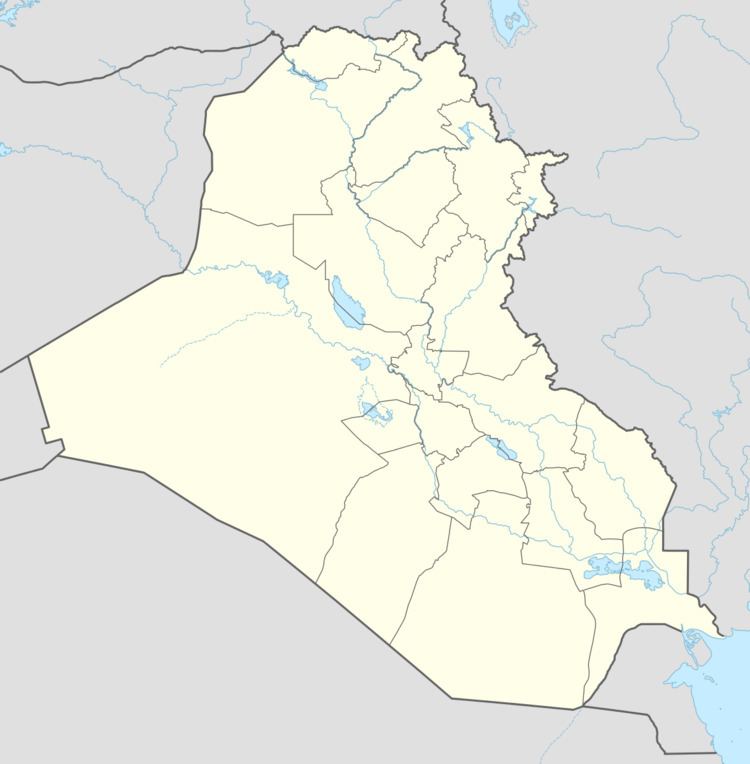District Tel Keppe District Local time Tuesday 1:20 PM | Governorate Ninawa Population 40,000 (2010) | |
 | ||
Demonym(s) Tel-Kepniyah (m) / Tel-Kepnetha (f) Weather 20°C, Wind SE at 23 km/h, 46% Humidity | ||
Tel Keppe (also spelled Tel Kaif) (Syriac: ܬܸܠ ܟܹܐܦܹܐ Tal Kepe, Arabic: تل كيف Tall Kayf), is an Assyrian town in northern Iraq. Its name means "Hill of Stones" in Syriac. It is located in the Ninawa Governorate, less than 8 miles north east of Mosul. The town is a historic farming town consisting of a densely populated core, surrounded by farm land outside of the city. All of its Assyrian residents fled for Iraqi Kurdistan and other parts of Iraq such as Baghdad in August 2014 after the invasion of the town by ISIS. The town was recaptured in January 2017.
Contents
- Map of Tall Kayf Iraq
- History
- Occupation by ISIS
- Climate
- Demographics
- Chaldeans today
- In the United States
- Elsewhere
- Culture
- Deceased
- Living
- References
Map of Tall Kayf, Iraq
History
In 1508, Tel Keppe was sacked by Mongols.
In 1743, Tel Keppe was looted and burned by the armies of the Persian leader Nader Shah. This event took place within the context of the Siege of Mosul, in which the Persian army suffered heavy casualties and resorted to looting the surrounding towns to have some semblance of victory.
In 1833, the town was once again sacked, this time by the Kurdish Governor of Rawandiz. He also sacked the nearby town of Alqosh.
Occupation by ISIS
On 6 August 2014, the town was taken over by the Islamic State of Iraq and Syria (ISIS), along with nearby Assyrian towns Bakhdida, Bartella and Karamlish. Upon entering the town, ISIS looted the homes, and removed the crosses and other religious objects from the churches. The Christian cemetery in the town was also later destroyed.
Soon after the beginning of the Battle of Mosul Iraqi troops advanced on Tel Keppe, but the fighting continued into 2017. Iraqi forces recaptured the town from ISIS on the 19th of January 2017.
Climate
Tel Keppe has a semi-arid climate (BSh) with extremely hot summers and cool, damp winters, typical to the Nineveh Plains.
Demographics
In 1768, the town had a recorded population of 2500. Due to plague and other disasters, the population was around 1500 in 1882, rising to 2500 again by 1891. In 1923, the population was recorded as 14,000. In 1933, the population numbered around 10,000. As a result of emigration from the town to Baghdad and the United States, the population shrunk to 7,108 by 1968.
The district of Tel Keppe was approximately Chaldean Catholic in the mid 1900s, the town of Tel Keppe remaining almost exclusively Christian with a population of 6,600 inhabitants.
Throughout the late 20th century, the town experienced non-native population growth from the arrival of Sunni Arabs, who established residence outside of the historic city core. By the turn of the century, the population had swelled to close to 30,000.
Chaldeans today
Starting in the 1980s and especially after the 1991 Gulf War and 2003 Invasion of Iraq, many Chaldean Catholic Assyrians from Tel Keppe fled to many countries, but primarily the United States. They set up their lives there with new churches and business for their families. By 2001 many from Tel Keppe had moved to major cities in Iraq such as Baghdad or Mosul.
In the United States
As of 2004, many of the Chaldean Catholic Assyrians in Metro Detroit trace their origins to Tel Keppe. According to the estimates of a priest of Tel Keppe's Sacred Heart Chaldean Rite Catholic Church, there were 10,000 worshipers in the late 1950s and this decreased to 2,000 around 2004. He said that "Many people don’t want to go from here; they cry that they have to go… But you almost have to leave these days because your family probably already is in Detroit."
Elsewhere
Tel Keppniyeh also fled to the neighboring countries of Syria and Iran. Many others also left to other countries including Sweden, America, France, other European countries and Australia.
Culture
Tel Keppe historically was the center of the Chaldean Catholic community of Iraq. Each family residing in Tel Keppe had one or more plots of farming land located outside of Tel Keppe. The land produced barley and wheat, and animals raised there included goats and sheep. Natalie Jill Smith, author of "Ethnicity, Reciprocity, Reputation and Punishment: An Ethnoexperimental Study of Cooperation among the Chaldeans and Hmong of Detroit (Michigan)", wrote that in the reports of the village "everyone was related" and that marriage tended to occur between two people from the same village.
